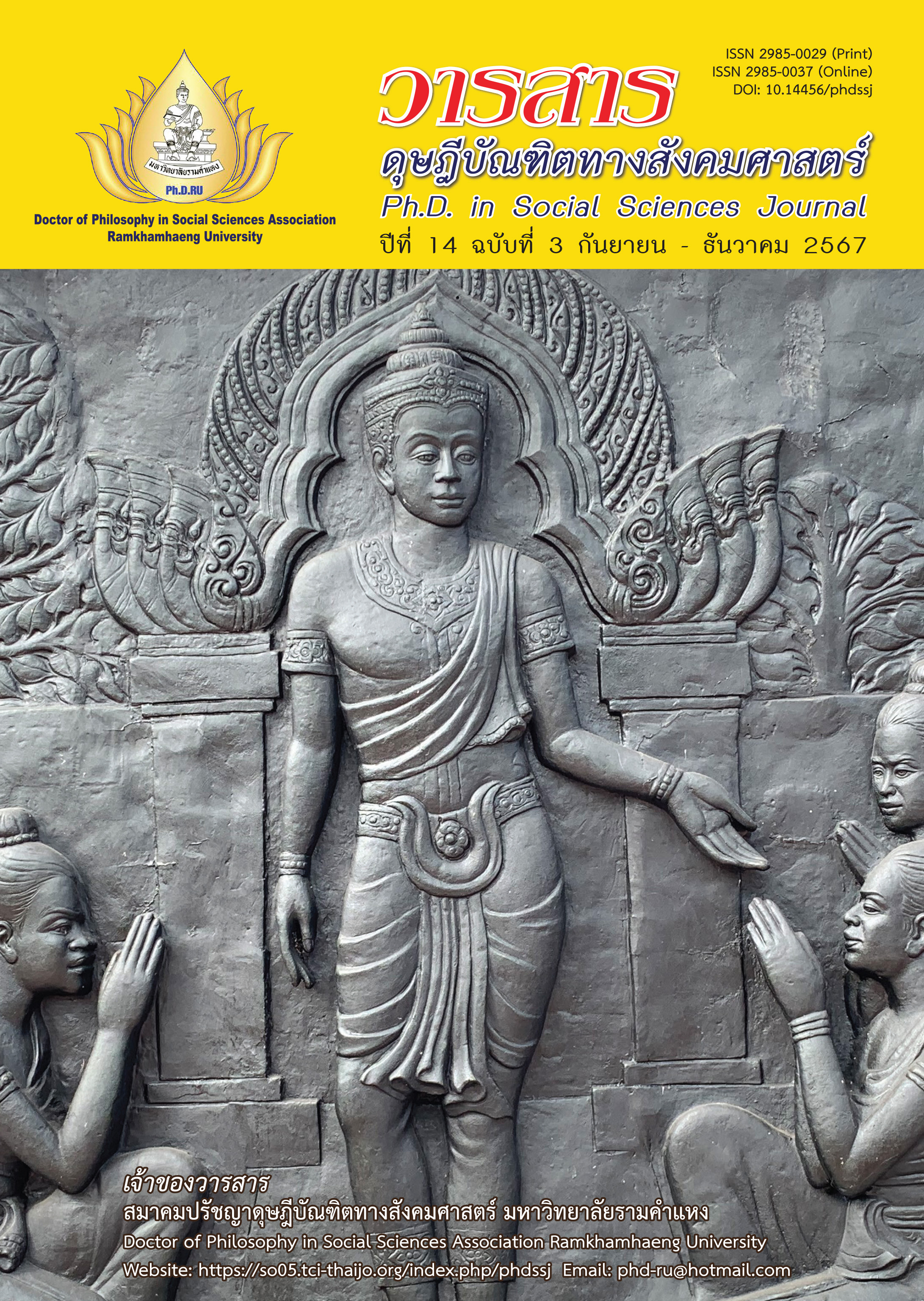กลยุทธ์ SPEED Model ที่ส่งผลต่อความไว้วางใจและความตั้งใจซื้อสินค้า OTOP จังหวัดนนทบุรี
Main Article Content
บทคัดย่อ
บทความวิจัยนี้มีวัตถุประสงค์เพื่อ (1) ศึกษาปัจจัยของกลยุทธ์ SPEED Model ที่มีอิทธิพลต่อความไว้วางใจสินค้า OTOP (2) ศึกษาปัจจัยของกลยุทธ์ SPEED Model ที่มีอิทธิพลต่อความตั้งใจซื้อสินค้า OTOP และ (3) ศึกษาความไว้วางใจสินค้าที่มีอิทธิพลต่อความตั้งใจซื้อสินค้า OTOP โดยดำเนินการวิจัยผสมวิธี (mixed method research) กลุ่มประชากรการวิจัยเชิงปริมาณ คือ ลูกค้าที่เข้าซื้อสินค้า OTOP จังหวัดนนทบุรี จำนวนทั้งหมด 400 คน โดยใช้แบบสอบถาม เพื่อวิเคราะห์สถิติ ได้แก่ ร้อยละ ค่าเฉลี่ย ส่วนเบี่ยงเบนมาตรฐาน และการวิเคราะห์โมเดลสมการโครงสร้าง กลุ่มประชากรการวิจัยเชิงคุณภาพ คือ ผู้ประกอบการสินค้าOTOP จังหวัดนนทบุรี จำนวนทั้งหมด 5 คน และผู้ทรงคุณวุฒิ จำนวน 3 คน โดยแบบสัมภาษณ์ในการสนทนากลุ่มเพื่อวิเคราะห์เชิงพรรณนา
ผลการวิจัย พบว่า (1) กลยุทธ์ SPEED Model (SPD) ที่มีอิทธิพลในเชิงบวกต่อความไว้วางใจ (TRU) (2) กลยุทธ์ SPEED Model (SPD) มีอิทธิพลในเชิงบวกต่อความตั้งใจซื้อ (PUC) และ (3) ความไว้วางใจ (TRU) มีอิทธิพลในเชิงบวกต่อความตั้งใจซื้อ (PUC) โดยสอดคล้องกับข้อมูลเชิงประจักษ์ โดยมีค่า p-value เท่ากับ 0.061 โดยตัวแปรในโมเดลสามารถอธิบายค่าดัชนีวัดระดับความสอดคล้องได้ร้อยละ 94.60 และในส่วนการวิจัยเชิงคุณภาพ ผลการวิจัย พบว่า ไม่มั่นใจว่าผู้ประกอบการจะดำเนินการแผนกลยุทธ์ได้อย่างต่อเนื่อง เพราะอาจขาดทรัพยากรและการสนับสนุนในระยะยาว ส่งผลให้เกิดข้อจำกัดในการนำกลยุทธ์ไปปฏิบัติจริง
Article Details

อนุญาตภายใต้เงื่อนไข Creative Commons Attribution-NonCommercial-NoDerivatives 4.0 International License.
บทความวิชาการ บทความวิจัย และบทวิจารณ์หนังสือในวารสารดุษฎีบัณฑิตทางสังคมศาสตร์ เป็นความคิดเห็นของผู้เขียน มิใช่ของคณะผู้จัดทำ และมิใช่ความรับผิดชอบของสมาคมปรัชญาดุษฎีบัณฑิตทางสังคมศาสตร์ มหาวิทยาลัยรามคำแหง (กรณีการทำวิจัยในมนุษย์ ผู้วิจัยต้องผ่านการอบรมจริยธรรมการวิจัยในมนุษย์ และนำหลักฐานมาแสดง)
เอกสารอ้างอิง
Cheng, X., Macaulay, L. (2014). Exploring individual trust factors in computer mediated group collaboration: A case study approach. Group Decision and Negotiation, 23(3), 533-560.
Goffin, R. D. (2007). Assessing the adequacy of structural equation models: Golden rules and editorial policies. Personality and Individual Differences, 42(5), 831-839.
Joshi, Y., & Rahman, Z. (2015). Factors affecting green purchase behaviour and future research directions. International Strategic Management Review, 3(1-2), 128-143.
Kanchanakijsakul, C. (2012). Research and methodology in social science. Project Five-Four. [In Thai]
Lim, Y. J., Osman, A., Salahuddin, S. N., Romle, A. R., & Abdullah, S. (2016). Factors influencing online shopping behavior: The mediating role of purchase intention. Procedia Economics and Finance, 35, 401-410.
Luhmann, N. (1979). Trust and power. John Wiley & Sons.
Mechinda, P. (2010). Consumer behavior. Dharmasarn. [In Thai]
Nitichaowakul, T. (2015). Building brand equity with logo of the One Tambon One Product. Academic Journal of Humanities and Social Sciences Burapha University, 23(42), 149-168. [In Thai]
Nyhan, R. C., & Marlowe, H. A. (1997). Development and psychometric properties of the organizational trust inventory. Evaluation Review, 21(5), 614-635.
Office of the National Economic and Social Development Council. (2022). The thirteenth national economic and social development plan (2023-2027). Author. [In Thai]
Pannim, A. (2017). Factors influencing intention to re-purchase clean food delivery. Master’s Thesis of Business Administration (Marketing), Silpakorn University. [In Thai]
Salisbury, W. D., Pearson, R. A., Pearson, A. W., & Miller, D. W. (2001). Perceived security and World Wide Web purchase intention. Industrial Management & Data Systems, 101(4), 165-177.
Sangkhamart, K. (2019). A model development of business strategies for new entrepreneur. Academic Journal Phranakhon Rajabhat University, 10(1), 221-237. [In Thai]
Sangtrakul, M. (2014). The influences of perceived value perceived quality value, and perceived emotion value on the trust satisfaction, word of mouth and repurchase of the healthy food restaurant in Bangkok. Master’s Independent Study of Business Administration, Bangkok University. [In Thai].
Schiffman, L. G., & Kanuk, L. L. (1997). Consumer behavior. Prentice Hall.
Schumacker, R. E., & Lomax, R. G. (2010). A beginner’s guide to structural equation modeling (3rd ed.). Routledge.
Shoosanuk, A., Kulnayu, M., Shoosanuk, C., & Phengpis, S. (2016). The influence of service quality on perceived value, customer satisfaction and customer loyalty of beauty clinic in Bangkok. Veridian E-Journal, Silpakorn University, 9(1), 1565-1584. [In Thai]
Thamizhvanan, A., & Xavier, M. J. (2013). Determinants of customers’ online purchase intention: An empirical study in India. Journal of Indian Business Research, 5(1), 17-32.
Yothinnorratham, S. (2014). The Influences of perceived value and service quality on the trust, satisfaction and revisit of the Oishi Grand’s customers. Master’s Independent Study of Business Administration, Bangkok University. [In Thai].


